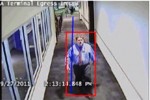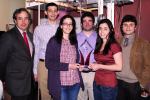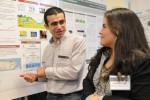News & Events
ALERT Program
Handheld IED Detection Device with Firestorm Emergency Services November 8, 2012

ALERT research out of Missouri University of Science and Technology, led by Prof. Daryl Beetner, is currently working to develop methods to indirectly detect and locate explosives by identifying the electromagnetic emissions from these electronic initiators. This approach has the advantage that a device can potentially be detected from tens or even hundreds of meters away in a very short period of time using relatively small, inexpensive, low-power sensors.
Hidden explosives can be extraordinarily difficult to locate. While the most obvious approach is to look for the explosive compound, techniques which look for these compounds often only work from short distances, can only be used over a very limited area, or are very slow to generate a detection. An alternative is to instead look for the electronic trigger that is used to initiate the explosive. Electronics used in triggers like timers, wireless receivers, motion detectors, and microcontrollers, emit electromagnetic energy (i.e. radio waves) when they are turned on. These radio waves can potentially be detected from long distances in a short period of time using relatively small, inexpensive, low-power sensors.
In the last year, Beetner and his team have developed techniques to locate (not just detect) radio receivers using a stimulated emissions approach. Detection of electronics has an advantage over many other explosives detection techniques in that it can potentially be done relatively quickly from relatively long range and can be done with relatively inexpensive equipment. It gives the bomb technician one more point of information with which to make a decision about the presence of explosives and how to deal with the explosives once found. As Beetner explains, “We’ve developed methods to accurately detect and locate the most common types of radio receivers. We’ve shown that these techniques are fast and work well at long distances, even in very noisy urban environments”. While detection of suspect electronics does not necessarily indicate the presence of an explosive device, this information can be combined with other information relatively easily to confirm or add information about a threat. The information is unique from other explosive sensors so it is well primed for sensor fusion.
ALERT has teamed up with Firestorm Emergency Services to develop a commercial product around algorithms developed by Beetner and his group. Firestorm manufactures a small, inexpensive, hand-held device for detecting and locating the electromagnetic signatures from aircraft emergency beacons and from radio location beacons worn by Alzheimer’s patients, so they already have hardware under development that is ideal for the team’s approach. The fundamental detection methods developed here are also being extended with Firestorm to develop systems for locating vehicles at remote border crossings.
Breakthroughs in Ionic Polymer Characterization November 7, 2012

Research led by ALERT investigator Prof. Louisa Hope-Weeks at Texas Tech University, could make the sensitive materials used in detonators safer for mining and military use, as well as less harmful to the environment. Ionic polymers, the class of materials the group works with, are less toxic but more unstable compared to the heavy metals used in current commercial detonators. By understanding the structures of the materials, Hope-Weeks and her group can then develop associated compounds to make the polymers more stable and a more viable option for use.
Currently, explosives used in the field are lead-based, causing detonations to have a huge environmental impact. Hope-Weeks states that the purpose of this research is, “similar to if you take lead out of paint. We are trying to replace lead-based energetic materials with greener compounds” The complexity of the problem is that the researchers are looking at ways to keep power output the same, but to lower the sensitivity of the polymers. The current compound is too sensitive for common use and requires further evolution to become less shock sensitive to make sure the item doesn’t react until a true signal is sent.
“We wanted to make an optically activated material,” explains Hope-Weeks, “so that if, for example, a bomb squad wanted to blow up a car they suspect has a terrorist device inside, they would have something they could remotely place under the car and then activate it with a laser, rather than someone having to go in there and wire it up.” The added benefit of this new lead-free device would be that it’s green; thus, causing less of a long-term impact on the environment.
The long-term goal of the work is to make an optically activated material where lasers could be used to activate the explosive from a far distance and eliminate the need for a person to have to wire the charge.
Transition Task at CLE: The Student Perspective November 6, 2012

The ALERT project VAST (Video Analytic Surveillance Transition) is an effort that addresses the needs of the TSA to monitor and mitigate threats by individuals to airport security. ALERT and the TSA Ohio Senior Federal Security Director put together a team of researchers from three COE partner universities (NEU, BU and RPI) and TSA practitioners to develop and transition solutions to “in-the-exit” and “tag and track” issues at Cleveland Hopkins International Airport (CLE). The VAST team also has an industrial partner, Siemens Corporate Research, to guide the technology transition into markets, and to lead the design and development of a testbed at CLE.
In an effort to educate the next generation of researchers, the COE partner universities have also brought on students to the teams. Tom Hebble, a student participating from Northeastern University explains, “We travel to Cleveland every week in order to install the software and collect results. Currently there are three universities working on this, and every week someone from one of the three is in Cleveland. Their job is to install the latest revision of their code, as well as collect the results from the previous week’s test, so every few weeks we’re getting a new revision out there and a few weeks of data to look at and analyze.” As stated by Post-doctoral researcher Mohamed Elgharib of Boston University, “Even though I’ve been in research for almost 4 years, ALERT was the first industry-like experience that I’ve been through. I’ve learned how to create a product that satisfies a wider community of end-users, rather than just satisfying a narrow community.” Ziyan Wu of Renssellaer Polytechnic Institute explains, “before this project, I wrote my code just to implement specific functions and make things work. This is the first time I’ve needed to seriously think about user experience, that is, I need to make my software user friendly and easy to understand. This software will be used for security surveillance, so I really need to ensure its reliability and robustness”.
Here, students realize that they are not just trying to solve a problem, they need to completely conquer it. That is to say that the algorithm developed needs to be applicable to every circumstance without exception or limitation. According to Binlong Li of Northeastern University, “it’s precious industry experience that is a big plus for newly graduated students. We are able to understand how a real project works and is developed in the industrial world. We get a good sense of how to transfer research techniques into real applications”. As Wu continues, “I understand that all research should originate from reality. It has to be rooted in the reality, serve the reality, and then enhance the reality”.
As Hebble closes, “it’s an experience of going through the design cycle of coming up with a new revision, looking at the results, making corrections, and seeing that cycle of looking at the results to find problems and coming up with new ways to solve them. This is a good experience from that standpoint, to get real hands-on design experience as well as the experience with the code.”
Associate Director presents at the first DHS Science and Technology(S&T) Research Council Webinar October 25, 2012

ALERT Associate Director, Carey Rappaport was invited to speak at the first DHS Science and Technology(S&T) Research Council Webinar on Monday, October 22nd. Prof. Rappaport participated in the Explosives Detection Panel, which discussed the Quadrennial Homeland Security Review mission flow down to potential technology solutions supported by S&T with subject matter experts (SMEs) from DHS labs, DOE National Labs, and S&T Centers of Excellence.
In addition to Prof. Rappaport, the panel also included:
Jon L. Maienschein, Ph.D.
Director, National Explosives Engineering Sciences Security Center
Director, LLNL Energetic Materials Center
Leader, PLS Energetic Materials Group
Physical and Life Sciences Directorate
Lawrence Livermore National Laboratory
Richard T. Lareau, Ph.D., Chief Scientist,
U.S. Dept. of Homeland Security
Science and Technology Directorate
Transportation Security Laboratory
David Atkinson, Ph.D., Chief Scientist
Explosives Detection Research
Pacific Northwest National Laboratory
Be one of the first to back FoRCE – a new product for Data Recovery July 6, 2012

Keith Bertolino, CEO and co-founder of Cipher Tech Solutions, and former Gordon Engineering Leadership student, is launching the prototype of FoRCE. Using an advanced method of digital forensics called “carving,” FoRCE would give even non-savvy computer users the ability to recover large amounts of deleted images, text, and other data files from Windows computers. In order to fund this project, Keith is leveraging Indiegogo to crowdfund his prototype.
Northeastern Students Capture 1st Place and $10,000 prize in 6th Annual National Security Innovation Competition May 7, 2012

Northeastern captured the top prize of $10,000 for their entry “Next Generation Millimeter-Wave Body Imaging for Concealed Threat Detection” in the 2012 National Security Innovation Competition (NSIC) held at the University of Colorado, Colorado Springs (UCCS).
Northeastern’s team consisted of ALERT graduate students Galia Ghazi, Luis Tirado, Kathryn Williams, and Spiros Mantzavinos with Professors Carey Rappaport and José A. Martinez-Lorenzo advising the team. Their project beat 39 other schools nationwide for the top prize.
The competition was among ten finalist teams from schools across the country and Canada, including USMA West Point who brought home the second place prize of $5,000, and the University of Calgary and UCCS, who won 3rd and 4th place, respectively.
The competition was judged by a panel of seven judges from government and industry that included representatives from the Department of Homeland Security (DHS), the Defense Advanced Research Projects Agency (DARPA), the Counter Terrorism Technical Support Office (CTTSO), Boeing Phantom Works, Paladin Capital Group, Popular Science Magazine, and Dorsey & Whitney LLP.
The purpose of the NSIC is to stimulate college student interest in addressing issues of national security by exposing their university-sponsored projects to a broad audience of industry, academic, and government organizations involved in aerospace, defense, security, and first responder activities.
Website for the NSIC competition
ALERT’s Standoff Detection System highlighted in Northeastern iNSolution March 16, 2012

iNSolution, Northeastern University’s Research Blog discusses ALERT’s Standoff Detection System with Profs. Carey Rappaport and Jose Martinez.
“The death toll in Jos, Nigeria after the most recent suicide bomb has climbed to 19. In our jaded world, that doesn’t seem so high. But nearly 13,000 individuals died from suicide attacks between 2003 and 2010, and clearly that number continues to rise.
Professors Carey Rappaport and Jose Martinez are using their skills in electromagnetic radiation to put an end to that…”
ALERT Research in Chemistry World January 13, 2012

ALERT research, led by Prof. Louisa Hope-Weeks at Texas Tech University, could make the sensitive materials used in highly explosive detonators safer for mining and military use, as well as less harmful to the environment.
Read MoreRICC Presentations & Posters Now Available for Download December 9, 2011

Selected presentations and posters are now available for viewing on the RICC website.
“Bomb Squad Plants” November 30, 2011
ALERT researcher Samuel Hernández-Rivera and team have their work investigating the ability of three Caribbean plants – Rubia tinctorum, Lippia dulcis and Spermacoce remota – to remove TNT featured in the November Issue of UK Royal Society of Chemistry’s “Chemistry World News”.
Read More
